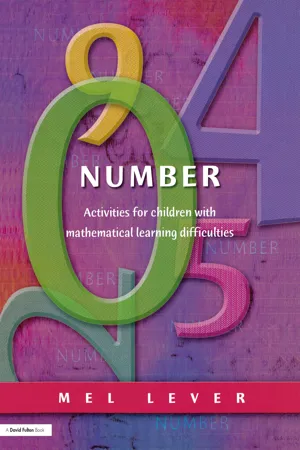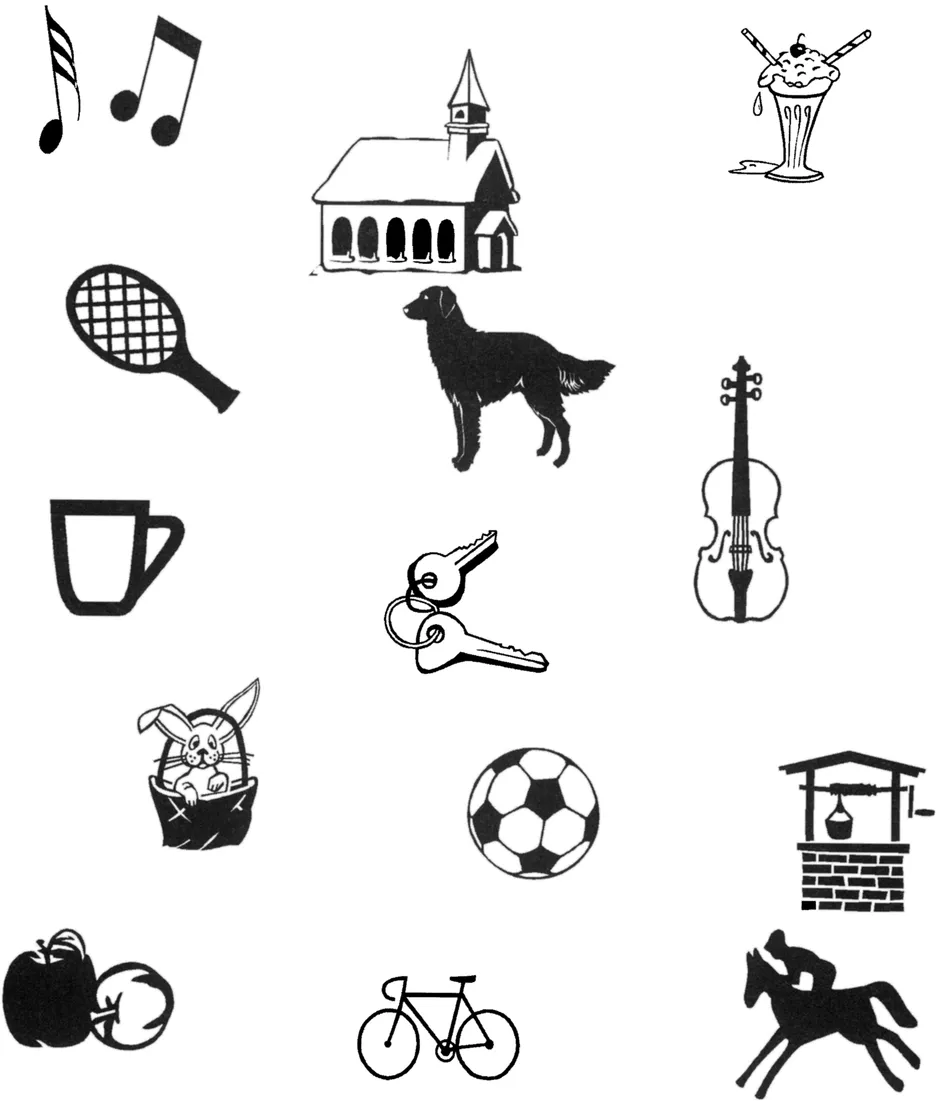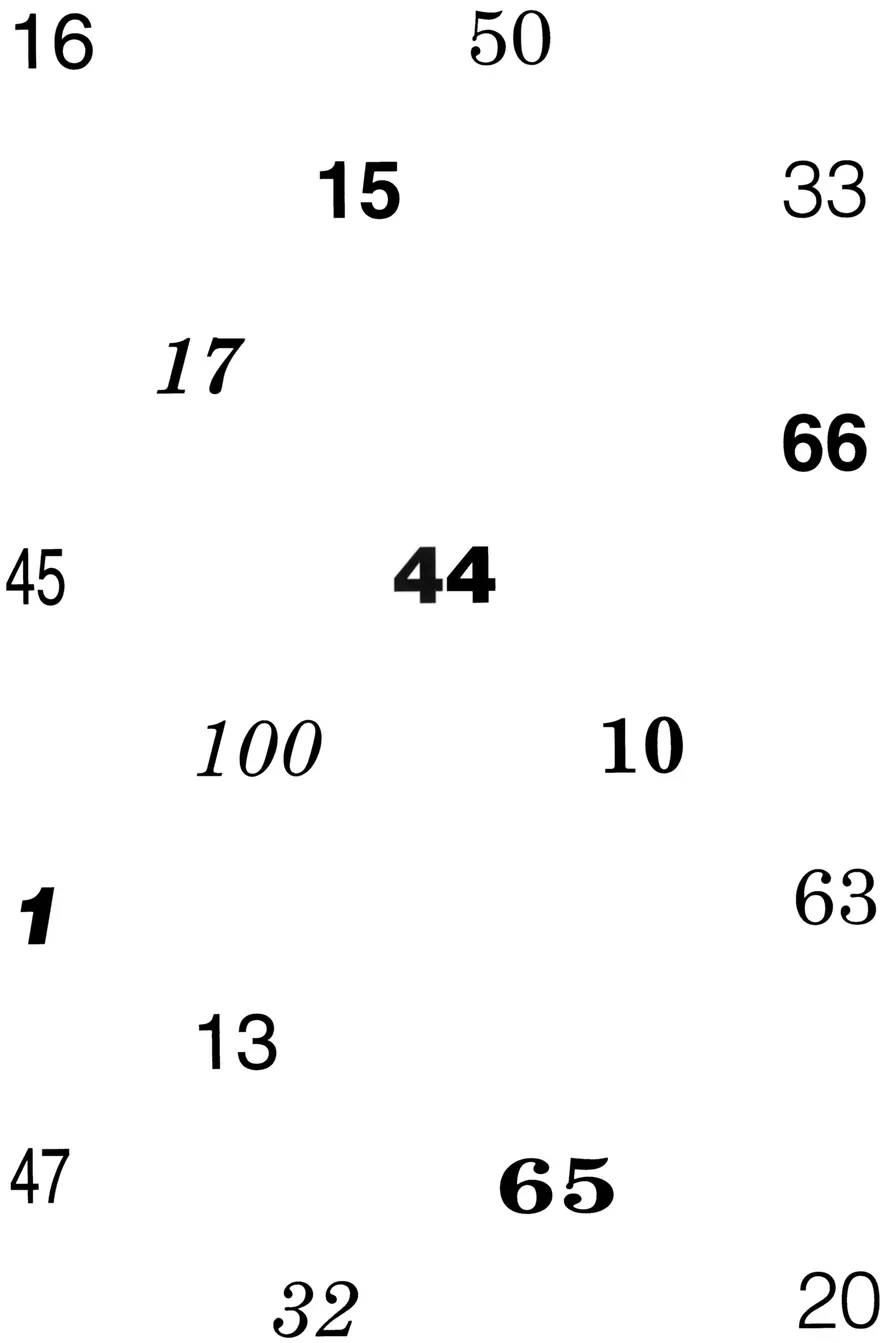
- 89 pages
- English
- ePUB (mobile friendly)
- Available on iOS & Android
eBook - ePub
About this book
First Published in 2003. This short series of three books - Number; Shape and Space; and Measures and Handling Data- gives teachers and parents a range of ideas to help children with mathematical learning difficulties get to grips with mathematics. In order to help these children effectively, statements and teaching points need to be rephrased and produced in a variety of ways, using concrete and pictorial aids. The activities in these books will help teachers to offer children a wide-ranging mathematical vocabulary - adding meaning to the words children already use rather than just adding words to their repertoire. these activities are flexible and can be used in any order with children of a range of ages and ability. Activities focusing on number includes: early counting activities; acquisition and use of number bonds; using the 100 square in understanding the four rules of number and number patterns; strategies to help with place value; an introduction to Maths Monster and activities to help memory training.
Frequently asked questions
Yes, you can cancel anytime from the Subscription tab in your account settings on the Perlego website. Your subscription will stay active until the end of your current billing period. Learn how to cancel your subscription.
At the moment all of our mobile-responsive ePub books are available to download via the app. Most of our PDFs are also available to download and we're working on making the final remaining ones downloadable now. Learn more here.
Perlego offers two plans: Essential and Complete
- Essential is ideal for learners and professionals who enjoy exploring a wide range of subjects. Access the Essential Library with 800,000+ trusted titles and best-sellers across business, personal growth, and the humanities. Includes unlimited reading time and Standard Read Aloud voice.
- Complete: Perfect for advanced learners and researchers needing full, unrestricted access. Unlock 1.4M+ books across hundreds of subjects, including academic and specialized titles. The Complete Plan also includes advanced features like Premium Read Aloud and Research Assistant.
We are an online textbook subscription service, where you can get access to an entire online library for less than the price of a single book per month. With over 1 million books across 1000+ topics, we’ve got you covered! Learn more here.
Look out for the read-aloud symbol on your next book to see if you can listen to it. The read-aloud tool reads text aloud for you, highlighting the text as it is being read. You can pause it, speed it up and slow it down. Learn more here.
Yes! You can use the Perlego app on both iOS or Android devices to read anytime, anywhere — even offline. Perfect for commutes or when you’re on the go.
Please note we cannot support devices running on iOS 13 and Android 7 or earlier. Learn more about using the app.
Please note we cannot support devices running on iOS 13 and Android 7 or earlier. Learn more about using the app.
Yes, you can access Number by Mel Lever in PDF and/or ePUB format, as well as other popular books in Education & Education General. We have over one million books available in our catalogue for you to explore.
Information
1 Number: Introduction
This is not intended to be a sequence of lessons, to be used one after the other. Instead, it is a collection of ideas for helping children to become interested in number, helping them to understand concepts, and engaging them in the learning process in a meaningful and stimulating way. I have given examples of ways in which we have helped children to be interested in and to understand maths. Many of these ideas can be adapted for use at various levels of understanding and development.
Children may have difficulties in the understanding of some areas only. They may fear the very idea of number. They may find the language used difficult to understand and remember, and to associate with concepts. Some children like to learn through deciphering messages on paper; some are stimulated when they receive ticks for their work. However, many others like to move around, to experiment, to discuss. With some children, teachers need to grab their attention with a new activity that will have an element of surprise.
I hope I have included a range of suggestions so that most parents and teachers of children with difficulties in working with number will be able to find something to stimulate these children.
With younger children it is inevitable that practical activities dominate maths lessons. With the pressures of testing and results, teachers often find that they are having to teach what to do and how to do it, having little time for the more creative teaching that we enjoyed in the past. We have found that one well-thought-out practical activity, that includes a lot of discussion and opportunities for children to express their ideas and to be physically as well as mentally involved, can help them make a major discovery, one that would take a lot longer to acquire if presented as a fact or a procedure.

Much of our teaching is concerned with repetition and explanation. Some of it asks the children to learn facts. We hope and believe that a lot of it is fun.
2 Memory Training
Many of the children I teach have difficulty retaining information. This is due to a variety of factors. During their early years children are constantly gaining in knowledge and understanding, and surprise us with how quickly they develop. However, for some children remembering facts and concepts is a difficulty throughout their school life. Most children need memory training as part of their usual school routine. Some need this more than others do. I am including the following ideas here, at an early stage of the book, but they can and should be used throughout the primary school.
Activity 1
- Put a variety of objects on a tray and show them to the children for one minute. Remove the tray and ask the children to draw or write down as many of the objects as possible. When the children read out their lists, ask what strategies they used to recall the objects.
- Do the same activity using geometric shapes.
- Reduce the time the objects are displayed.
Activity 2
- Show the children a large sheet with pictures of objects on it (or use an OHP transparency — see Photocopiable Sheet A). Again, show the sheet for one minute, remove and ask children to recall what they saw. Discuss strategies for recall. It is fun to make up your own sheet of objects, including some pictures that have featured in class work recently.
- Do the same activity with numbers, using a variety of sizes and colours (see Photocopiable Sheet B, but again, make up your own).
- Repeat this with a sheet of geometrical shapes (see Photocopiable Sheet C).
- Think of other concepts or ideas that you want the children to revise. For instance, you could make a sheet of sums, using specific mathematical symbols.
In these activities an important part of the exercise is discussing strategies for recall. Many children with learning difficulties will need help in devising such strategies. Other children may say that, with objects or pictures of objects, they put them into categories according to use or family. They may have remembered the initial letters of the objects. They may have looked for connections between various objects. Some may have made up stories. With those children who have not devised such strategies it is important to help them choose one that suits them.
Resources
- Tray
- Variety of objects
- Geometric shapes
- OHP
- Transparent sheet of pictures (Photocopiable Sheet A)
- Transparent sheet of numbers (Photocopiable Sheet B)
- Transparent sheet of shapes (Photocopiable Sheet C)
- Transparent sheet of sums with signs

Photocopiable Sheet A

Photocopiable Sheet B

Photocopiable Sheet C
3 Numbers as Digits (1)
Young children often arrive at school counting and writing numbers in a fashion and having some knowledge of adding things together. Some children are already showing a good understanding, but some are having real difficulties. Our dyslexic and dyspraxic children often have difficulties with the fundamental maths activities and concepts. The following are some ideas to help children build up their skills.
Activity 1
Ask children to trace over large numerals, with clearly marked beginnings and ends.
Activity 2
Give the children pictures of numerals and ask them to copy them with plasticine.
Activity 3
Ask children to write numerals in sand and compare with their neighbour.
Activity 4
Ask children to write against a vertical line. This is an idea to help children who persist with reversals while progressing in other areas of number work. (I learned it from Joyce Steeves at a lecture in New York.) With a right-handed child, present the vertical line. Ask the child to write the numbers attached to the right of the line (the side of the line near their writing hand), starting from the line when possible and starting as near as possible to the line otherwise (Figure 3.1).
With left-handed children the instructions include that the child writes on the side away from his or her writing side.
I developed this idea a step further with a right-handed child. I handed him a ruler and asked him to hold this vertically on a paper in front of him and to write his numerals against the side of it. This was a great success and he could grab his ruler and practise at any odd moment. This method is not possible for a left-handed child.

Figure 3.1: Writing numbers against a vertical line
Resources
- Tracing paper
- Sand tray
- Plasticine
- Pencils
- Paper
- Rulers
4 Numbers as Digits (2)
Children often learn to chant numbers in order, but have little idea of the meaning of their words. They may also write numerals, but be unsure about their meaning. Numerals are displayed in the classroom with pictures to illustrate their meaning. During all the common activities children tend to pick up their meaning. However, for a few children, the attachment of a meaningful and remembered label is a real difficulty
It is useful to display patterns of numbers. Most children are familiar with the arrangements of the dots on dice or dominoes. Display these and use them to break down numbers ...
Table of contents
- Cover
- Title
- Copyright
- Contents
- Foreword
- Introduction to the Series
- Acknowledgements
- 1 Number: Introduction
- 2 Memory Training
- 3 Numbers as Digits (1)
- 4 Numbers as Digits (2)
- 5 Number Bonds and Beach Huts
- 6 Teaching Number Bonds by Wearing Silly Hats
- 7 Number Bonds with an Addition Square
- 8 Number Bonds with a Difference Square
- 9 Place Value with Early Learners
- 10 Bonds and Loops
- 11 Place Value: The Mushroom Story
- 12 Place Value: Column Addition
- 13 Place Value: Standard Algorithm
- 14 Place Value: Column Subtraction
- 15 Place Value: Whole Numbers and Decimals
- 16 Missing Number Calculations
- 17 Bingo
- 18 The 100 Square
- 19 Fractions
- 20 Negative Numbers
- 21 What is the Bank Balance?
- 22 Mental Arithmetic
- 23 Mental Arithmetic Using Number Cards
- 24 Activities Using Dice
- 25 Practising Basic Number Skills with Monster Maths
- 26 Blockbusters
- 27 A Project on Travel
- 28 Who Wants to be a Maths Millionaire?
- 29 Multiplication Tables
- 30 Finger Tables
- 31 Three in a Row - a Tables Game